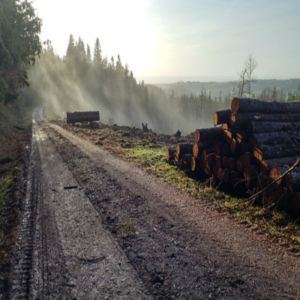End Coating Logs Can Maintain Value

Costs and Benefits
We can avoid many log and lumber related problems if we simply process the logs into lumber as soon as possible. Rapid utilization will minimize or prevent end checking, insect infestation, stain, and decay for both hardwood and softwood logs. The biggest reason is the longer we wait to process a log then the greater the odds that the lumber from the logs is losing value.
Logs can be end-coated with a wax-based coating to stop checking and maintain value. Losses from stain or splitting have been estimated at approximately $10 per inch of defect. It has been shown that the application of an end coating can reduce blue stain in hard maple logs by as much as 9 inches per log and reduce end splitting in red oak by 6 inches. The bottom line is that end coating can result in a savings of more than $36 per thousand board feet. The cost of end coating is typically less than $3 per thousand board feet.
Reducing End Splits
Time is our enemy with end splits. As soon as a tree is bucked into logs, the ends of the logs will begin to dry. End checking, like most wood problems, is a greater problem in the summer due to higher temperature and more exposure to sunlight due to longer days. Moisture leaves the ends of logs (and lumber) at about 10-15 times greater than the other surfaces. So, we have moisture leaving at differing rates which accelerates the natural differential shrinkage of wood. Cracks form as a result of the stresses created due to differential shrinkage. If you want a good illustration of this, cut a 1-3 inch disk from a log and watch what happens.
It is important to know the limitations of end coating. If you cut a leaning tree, it will likely have “reaction wood.” This is commonly seen as eccentric growth rings. These trees have internal stresses which are released when the tree is bucked into logs. The stresses will continue to be released and end splitting will occur as the log dries regardless of any end coating.
Reducing Stain
Fungal stain loves warm weather. The sapwood of log ends and debarked surfaces are especially susceptible to stain. Fungal stains appear as a blue, black, or similar dark color. The commonly used term “blue stain or sap stain” refers to the blue colored stain that is particularly common in softwood logs and lumber but can also be present in hardwoods. Blue stain occurs because fungi “colonize” the wood surface and feed off the wood sugars and starches in the sapwood. This stain does not significantly affect any strength properties of the wood but does reduce the value because of the reduced aesthetical appearance. This is particularly true for hardwood lumber.
So how do I control stain? The same way you control any wood fungi or insect. You eliminate one of the four requirements for active growth: (1) water- reduce the moisture content below 22%, (2) oxygen- logs stored under a sprinkler system or in a pond will not be attacked because of the anaerobic environment, (3) ) temperature- avoid temperatures between 70 – 90 F, and (4) food. The wood is the food and an appropriate preservative treatment will render the food unusable. End coatings provide a barrier to separate the fungi from the food source.
Checks are especially problematic because they allow fungal stain to enter the wood at the same depth as the check. This will result in stain in the inner portion of the wood. I have seen some mill operators plane a board to remove stain and essentially pass the board through the planer so many times that the board is now a tooth pick! This is a tremendous waste of time and money. So end coating will reduce fungal stain and end checking but does nothing for chemical or enzymatic stains that are common to many hardwood species.
Meet the Author
Dr. Todd Shupe is the President of Wood Science Consulting, LLC. He is a well-recognized expert on wood forensics, wood preservation, wood decay and degradation, and wood species identification. He has a broad background in new product development, quality management, and marketing and sales in both the public and private sectors. For more information please visit DrToddShupe.com.
We welcome your comments below.
Thank you for visiting. We trust that you have enjoyed reading our articles.
Liked this post? Read more below or search for more topics . . .

